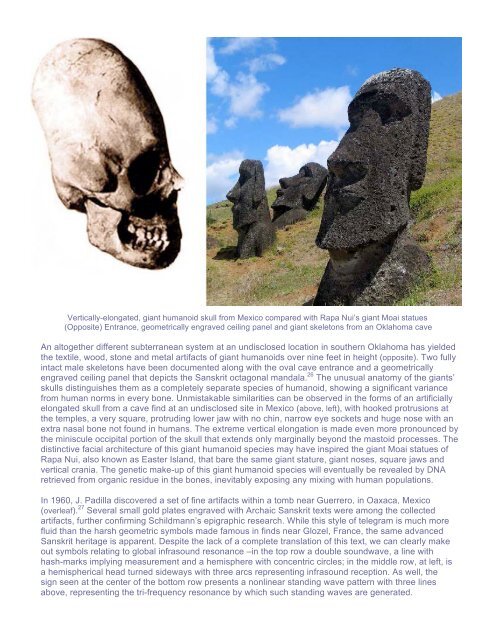Sanskrit
Sanskrit
Sanskrit
You also want an ePaper? Increase the reach of your titles
YUMPU automatically turns print PDFs into web optimized ePapers that Google loves.
Vertically-elongated, giant humanoid skull from Mexico compared with Rapa Nui’s giant Moai statues<br />
(Opposite) Entrance, geometrically engraved ceiling panel and giant skeletons from an Oklahoma cave <br />
An altogether different subterranean system at an undisclosed location in southern Oklahoma has yielded<br />
the textile, wood, stone and metal artifacts of giant humanoids over nine feet in height (opposite). Two fully<br />
intact male skeletons have been documented along with the oval cave entrance and a geometrically<br />
engraved ceiling panel that depicts the <strong>Sanskrit</strong> octagonal mandala. 26 The unusual anatomy of the giants’<br />
skulls distinguishes them as a completely separate species of humanoid, showing a significant variance<br />
from human norms in every bone. Unmistakable similarities can be observed in the forms of an artificially<br />
elongated skull from a cave find at an undisclosed site in Mexico (above, left), with hooked protrusions at<br />
the temples, a very square, protruding lower jaw with no chin, narrow eye sockets and huge nose with an<br />
extra nasal bone not found in humans. The extreme vertical elongation is made even more pronounced by<br />
the miniscule occipital portion of the skull that extends only marginally beyond the mastoid processes. The<br />
distinctive facial architecture of this giant humanoid species may have inspired the giant Moai statues of<br />
Rapa Nui, also known as Easter Island, that bare the same giant stature, giant noses, square jaws and<br />
vertical crania. The genetic make-up of this giant humanoid species will eventually be revealed by DNA<br />
retrieved from organic residue in the bones, inevitably exposing any mixing with human populations.<br />
In 1960, J. Padilla discovered a set of fine artifacts within a tomb near Guerrero, in Oaxaca, Mexico<br />
(overleaf). 27 Several small gold plates engraved with Archaic <strong>Sanskrit</strong> texts were among the collected<br />
artifacts, further confirming Schildmann’s epigraphic research. While this style of telegram is much more<br />
fluid than the harsh geometric symbols made famous in finds near Glozel, France, the same advanced<br />
<strong>Sanskrit</strong> heritage is apparent. Despite the lack of a complete translation of this text, we can clearly make<br />
out symbols relating to global infrasound resonance –in the top row a double soundwave, a line with<br />
hash-marks implying measurement and a hemisphere with concentric circles; in the middle row, at left, is<br />
a hemispherical head turned sideways with three arcs representing infrasound reception. As well, the<br />
sign seen at the center of the bottom row presents a nonlinear standing wave pattern with three lines<br />
above, representing the tri-frequency resonance by which such standing waves are generated.


